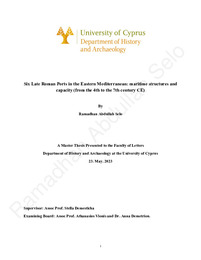Six late Roman ports in the Eastern Mediterranean: maritime structures and capacity (from the 4th to the 7th century CE)

View/
Date
2023-05-23Author
Selo, Ramadhan A.Publisher
Πανεπιστήμιο Κύπρου, Φιλοσοφική Σχολή / University of Cyprus, Faculty of LettersPlace of publication
CyprusGoogle Scholar check
Keyword(s):
Metadata
Show full item recordAbstract
This thesis examines six ports located in the Eastern Mediterranean region during Late Roman period, Alexandria in Egypt; Caesarea in Judea; Paphos in Cyprus, Elaiussa Sebaste and Soli-Pompeopolis in Cilicia and Patara in Lycia. To address the stud's aims, published books, articles, excavation reports and discoveries are used. The geography of the Roman empire shifted in the 4th century CE, with the Eastern area becoming the core of a distinct empire known as Byzantine. Christianity was formally recognized as the Empire's faith. The port network of this part most likely received the majority of maritime activities while the western part declined. The aim of this thesis is to investigate the characteristics of the structures of these ports and their building techniques and technology. Why not even one new port was built there during this period and how the existed ports were adapted to the maritime needs. As well as the capacity of each port in their respective locations in terms of basin area, quay length and the number of ships that a port could accommodate. GIS is utilized to compute the dimensions of estimated basin areas and quay space, while AutoCad is employed to generate some hypothetical drawings for specific ports when ships would be moored on their expected quay.
According to the results of this study, the Late Roman period probably did not employ hydraulic concrete as the most sophisticated technique in port renovation projects, but instead depended on alternate materials. It suggests that a new port was not established owing to economic concerns, as creating a port needed a significant budget, and the existing ports were meeting their demands by developing better facilities and maintaining current port infrastructure. Alexandria, as predicted, stands out in terms of capacity. Caesarea and Paphos are somehow comparable, while others are significantly smaller. However, it appears that these ports were effectively functioning as economic and sociopolitical centers for their respective areas.
